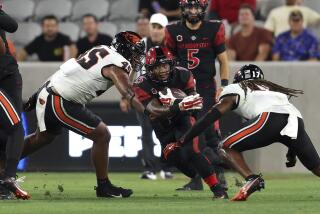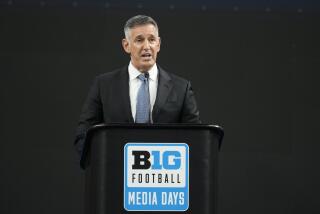Merger Creates Dynamite Dozen
- Share via
Texas Tech Coach Spike Dykes, son of a cotton ginner, was born in Lubbock. He watched oil make the town rich and rocker Buddy Holly make it famous.
At 57, he has seen passing fads, the Edsel come and go, the Cold War, twisters, John David Crow.
So, when his Red Raiders were thrown into the teeth of the new Big 12 conference, a mega-merger of the Big Eight and half of the defunct Southwest, Dykes tried to be philosophical.
“I don’t guess you can stand in the way of progress,” he said over the phone.
Progress, in this case, was a bulldozer coming in to level the landscape.
In college football’s answer to the Time Warner-Turner merger, two of the nation’s most celebrated conferences have joined forces, for better or worse, depending on what side of the score you end up on.
The coalition was formed after the demise of the scandal-torn Southwest Conference, which disbanded last season after 82 seasons of pomp and payoffs.
The best teams in the SWC--Texas, Texas A&M;, Texas Tech, Baylor--were absorbed by the Big Eight, producing an instant super conference.
The leagues’ combined histories is flat-out chest-thumping: 130 NCAA titles, 15 wire-service football champions, nine Heisman Trophy winners.
This year’s Big 12 includes seven teams that finished in the top 25 last season. Big 12 teams were 6-1 in bowl games and produced Nebraska, the consensus national champion.
Eight Big 12 players were named first team All-Americans.
The conference has been divided into two divisions. The North includes Nebraska, Colorado, Kansas, Kansas State, Missouri and Iowa State. In the South are Texas, Texas A&M;, Texas Tech, Oklahoma, Oklahoma State and Baylor.
The league wasted little time rolling up its sleeves. At a time when conferences have wrested television clout from the NCAA and the lame-duck College Football Assn., the Big 12 struck the largest television pact ever signed by a conference, an eight-year, $126-million deal with ABC and Fox Sports Net.
Last year, the Southeastern Conference, the consortium by which all others had been measured, brought in $45.5 million in television revenue. This year the Big 12 is projecting a gross of at least $47 million.
“This conference has all the clout to be a leader with all the other conferences in the country,” Big 12 Commissioner Steve Hatchell said. “Whether it’s success on the field, enrollment, alumni groups, TV contracts, TV sets, this is a major player.”
Few would argue.
The stakes have been raised dramatically.
Take Texas Tech. Dykes spent years rebuilding the Red Raiders to respectability and has led the team to bowl games the last three seasons.
But matching last year’s 9-3 record this year will be difficult.
Last season, Tech played three SWC opponents--Southern Methodist, Rice and Houston--that finished with a combined record of 5-27-1. This season, the Red Raiders sub in three Big 12 opponents--Kansas, Kansas State and Nebraska--which finished 32-4.
“This is a great opportunity,” Dykes said cautiously. “People like us, we’re like Avis, No. 2 and trying harder. This is going to force our hand, make us upgrade some things and push hard to hang in with the rest of those guys.”
For those less talented than Texas Tech, the task is more daunting. Iowa State, though it had a 2,000-yard rusher in Troy Davis, finished 3-8 in the Big Eight.
“I spent 24 years in the Big Ten [at Iowa and Wisconsin] and I believe that the Big 12 will be the premier football conference in the country,” Iowa State Coach Dan McCarney said. “The talent, the programs, the tradition, the coaching staffs--it is a really amazing league. It’s going to be real competitive and I don’t want Iowa State to be a weak link.”
Even the strong links will be tested. Colorado, a top-five team, will probably have to defeat division mate Nebraska to even get a shot at the Big 12 title game.
“It’ll be a heightened competition situation,” Buffaloes’ Coach Rick Neuheisel says. “It’ll tax teams’ depth. That’ll be a major issue in this conference.”
The rise of the Big 12 will be watched with great interest, although not everyone is convinced that the new alliance will leave others in its wake.
“I’m not sure the Big 12 is any more stable,” one Division I-A commissioner said.
He noted the infighting that went on in piecing together the alliance.
Conflicts broke cleanly between old Big Eight members and the incoming block of Texas schools.
Texas, for example, threatened to pull out and take a standing offer from the Pac-10 if stronger academic requirements were not imposed.
Texas won out.
In fact, the old Big Eight guard would argue that the Texas bloc pushed through much of its mandate.
The Texas schools prevailed in the battle for commissioner, former SWC commissioner Hatchell over Kansas Athletic Director Bob Frederick; the site of the new Big 12 headquarters, Dallas over Kansas City, where the Big Eight had been headquartered since 1907, and the issue of admitting non-qualifiers.
Nebraska, two-time defending national champion and winner of 25 straight on the field, went 0-5 in votes cast. The Cornhuskers lost on the selection of commissioner, conference headquarters, the league title game, the vote on non-qualifiers, and the addition of another conference game to the schedule.
Nebraska opposed, as did 11 of the conference’s 12 coaches, the decision to hold a conference title game on Dec. 7 in St. Louis. For the Cornhuskers, it essentially means having to play an additional national title game.
Nebraska also disagreed with the school presidents’ decision to not allow schools to accept non-qualifiers. In the past, the Cornhuskers had taken an average of two a season, according to Coach Tom Osborne.
A non-qualifier is a student who fails to meet both the GPA and standardized test score requirements. If accepted, the student is allowed to attend school as a freshman but cannot receive a scholarship or practice with the team.
The Big 12 approved the admitting of four partial-qualifiers per year per school, but only one in football. A partial-qualifier is a student who meets one of the academic requirements. The student is ineligible to play as a freshman, but can practice with the team and receive financial aid.
The new rule did not prevent Nebraska from reaping another top-10 recruiting class, but Osborne says it will be more difficult for the Big 12 to compete in the long run.
“There have been so many doors closed,” Osborne says. “The Big 12 has closed the Proposition 48 alternative, which we think has been a good one. We’ve taken about two per year and they’ve graduated at a good rate. We feel that there’s a place for those players.”
One commissioner said the wedge issues may eventually drive some schools out of the conference.
(BEGIN TEXT OF INFOBOX / INFOGRAPHIC)
Big Deals in Big 12
Nine Heisman Trophy winners from schools that will be in the Big 12 Conference:
*--*
Year Player Po School 1952 Billy Vessels RB Oklahoma 1957 John David Crow RB Texas A&M; 1969 Steve Owens RB Oklahoma 1972 Johnny Rodgers WB Nebraska 1977 Earl Campbell RB Texas 1978 Billy Sims RB Oklahoma 1983 Mike Rozier RB Nebraska 1988 Barry Sanders TB Oklahoma State 1994 Rashaan Salaam RB Colorado
*--*
National championship winners from schools that will be in the Big 12:
*--*
Team Seasons Oklahoma 1950, ‘55, ‘56, ’74 (AP only), ‘75, ’85 Texas 1963, ‘69, ’70 (UPI only) Texas A&M; 1939 Colorado 1990 (AP only) Nebraska 1970 (AP only), ‘71, ‘94, ’95
*--*
New-Look Conferences
Three conferences that added or changed members from the 1996 season:
BIG 12
(FORMERLY THE BIG EIGHT)
NORTH DIVISION
*--*
Team 1995 Conf Record Colorado Big Eight 9-2-0 Kansas Big Eight 9-2-0 Kansas State Big Eight 9-2-0 Iowa State Big Eight 3-8-0 Missouri Big Eight 3-8-0 Nebraska Big Eight 11-0-0
*--*
SOUTH DIVISION
*--*
Team 1995 Conf Record Baylor Southwest* 7-4-0 Oklahoma Big Eight 5-5-1 Oklahoma State Big Eight 3-8-0 Texas Southwest* 10-1-0 Texas A&M; Southwest* 8-3-0 Texas Tech Southwest* 8-3-0
*--*
* Conference no longer exists.
WESTERN ATHLETIC
MOUNTAIN DIVISION
*--*
Team 1995 Conf Record Brigham Young Western Athletic 7-4-0 New Mexico Western Athletic 4-7-0 Rice Southwest* 2- 7-1 Southern Methodist Southwest* 1-10-0 Texas Christian Southwest* 6-5-0 Texas El Paso Western Athletic 2-10-0 Tulsa Independent 4-7-0 Utah Western Athletic 7-4-0
*--*
* Conference no longer exists.
PACIFIC DIVISION
*--*
Team 1995 Conf Record Air Force Western Athletic 8-4-0 Colorado State Western Athletic 8-3-0 Fresno State Western Athletic 5-7-0 Hawaii Western Athletic 4-8-0 Nevada Las Vegas Big West 2-9-0 San Diego State Western Athletic 8-4-0 San Jose State Big West 3-8-0 Wyoming Western Athletic 6-5-0
*--*
BIG WEST
*--*
Team 1995 Conf Record Boise State *Big Sky 7-4-0 Idaho *Big Sky 6-5-0 Nevada Big West 9-2-0 New Mexico State Big West 4-7-0 North Texas Independent 2-9-0 Utah State Big West 4-7-0
*--*
* Division I-AA
Note--Teams no longer in Big West from 1995 season are Arkansas State (independent), Louisiana Tech (independent), Nevada Las Vegas (Western Athletic), Northern Illinois (independent), Pacific (dropped football), San Jose State (Western Athletic), Southwestern Louisiana (independent).
Brand New Conference
CONFERENCE USA
*--*
Team 1995 Conf Record Cincinnati Independent 6-5-0 Louisville Independent 7-4-0 Houston Southwest* 2-9-0 Memphis Independent 3-8-0 Southern Miss. Independent 5-5-0 Tulane Independent 2-9-0
*--*
* Conference no longer exists.
More to Read
Go beyond the scoreboard
Get the latest on L.A.'s teams in the daily Sports Report newsletter.
You may occasionally receive promotional content from the Los Angeles Times.











